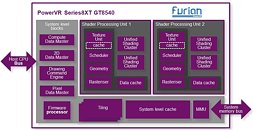Thursday, January 25th 2018
Imagination Announces Furian Architecture Four-cluster PowerVR Series8XT GPU
Imagination Technologies announces a new, high performance GPU core that supports the multiple, ultra-high resolution displays for cluster, Head-Up Display (HUD) and infotainment that automotive manufacturers are fitting to car interiors from 2018 onwards. Thanks to an 80% fillrate density improvement over the previous generation, the Furian Architecture-based four-cluster PowerVR Series8XT GT8540 GPU can simultaneously drive up to six 4K screens with complex UIs at 60fps.
Leveraging its built-in hardware virtualization capability, the new four-cluster PowerVR Series8XT enables automotive OEMs to deliver secure, high-performance graphics capabilities for a vehicle's many displays. PowerVR hardware virtualization can provide a complete separation of services and applications, ensuring they remain secure against system intrusion or data corruption. The platform can support up to eight applications or services running in separate containers at once and automotive OEMs can deploy and remove services at will without affecting others running at the same time.As more in-car infotainment systems move towards richer operating systems, such as Android which offer capabilities to run Apps, the importance of a GPU capable of full hardware virtualization to contain rogue apps is of increasing importance. Allowing a rich graphical environment for the infotainment system, safe in the knowledge that the dashboard and other critical displays will be unaffected by malware with a single PowerVR GPU, enables higher levels of system integration, reducing costs, whilst maintaining the safety critical requirements of the design.
With enhanced design flexibility over the previous generation, the PowerVR four-cluster Series8XT enables automotive OEMs to design their systems to prioritize either graphics or compute-based applications. The Series8XT GT8540 can support long-running compute workloads on a single Shader Processing Unit (SPU) for ADAS functions such as lane departure warning, blind-spot detection, and surround view, amongst others. Other tasks, such as infotainment and cluster, can run on the second SPU, using prioritizing mechanisms to reach system performance targets.Dominique Bonte, Managing Director and Vice President, ABI Research, says: "With the PowerVR Series8XT GT8540 Imagination Technologies continues to prove that it is a leader in the automotive space. As the automotive industry moves closer to introducing Level 4 and Level 5 autonomous vehicles, powerful GPUs will be vital to power multiple high-resolution display. With distraction concerns removed in driverless cars, additional opportunities for advanced infotainment features including 5G-based 4K video streaming will emerge in the longer term. Imagination is in a strong position to support this progression. The ability to run multiple workloads over each SPU is a potential game changer for the automotive industry."
Graham Deacon, Vice President PowerVR Marketing, Imagination Technologies, says: "PowerVR has a strong roadmap and this is reflected in the great success seen with the XT family and its selection by leading automotive players, such as Texas Instruments. We're now targeting new markets with the rich features, such as safety and security through virtualization."
The PowerVR Series 8XT GT8540 is now ready for licensing. The PowerVR two-cluster Series8XT GT8525 has customers in segments including automotive and mobile.
Sources:
Imagination, via Hexus.net
Leveraging its built-in hardware virtualization capability, the new four-cluster PowerVR Series8XT enables automotive OEMs to deliver secure, high-performance graphics capabilities for a vehicle's many displays. PowerVR hardware virtualization can provide a complete separation of services and applications, ensuring they remain secure against system intrusion or data corruption. The platform can support up to eight applications or services running in separate containers at once and automotive OEMs can deploy and remove services at will without affecting others running at the same time.As more in-car infotainment systems move towards richer operating systems, such as Android which offer capabilities to run Apps, the importance of a GPU capable of full hardware virtualization to contain rogue apps is of increasing importance. Allowing a rich graphical environment for the infotainment system, safe in the knowledge that the dashboard and other critical displays will be unaffected by malware with a single PowerVR GPU, enables higher levels of system integration, reducing costs, whilst maintaining the safety critical requirements of the design.
With enhanced design flexibility over the previous generation, the PowerVR four-cluster Series8XT enables automotive OEMs to design their systems to prioritize either graphics or compute-based applications. The Series8XT GT8540 can support long-running compute workloads on a single Shader Processing Unit (SPU) for ADAS functions such as lane departure warning, blind-spot detection, and surround view, amongst others. Other tasks, such as infotainment and cluster, can run on the second SPU, using prioritizing mechanisms to reach system performance targets.Dominique Bonte, Managing Director and Vice President, ABI Research, says: "With the PowerVR Series8XT GT8540 Imagination Technologies continues to prove that it is a leader in the automotive space. As the automotive industry moves closer to introducing Level 4 and Level 5 autonomous vehicles, powerful GPUs will be vital to power multiple high-resolution display. With distraction concerns removed in driverless cars, additional opportunities for advanced infotainment features including 5G-based 4K video streaming will emerge in the longer term. Imagination is in a strong position to support this progression. The ability to run multiple workloads over each SPU is a potential game changer for the automotive industry."
Graham Deacon, Vice President PowerVR Marketing, Imagination Technologies, says: "PowerVR has a strong roadmap and this is reflected in the great success seen with the XT family and its selection by leading automotive players, such as Texas Instruments. We're now targeting new markets with the rich features, such as safety and security through virtualization."
The PowerVR Series 8XT GT8540 is now ready for licensing. The PowerVR two-cluster Series8XT GT8525 has customers in segments including automotive and mobile.



13 Comments on Imagination Announces Furian Architecture Four-cluster PowerVR Series8XT GPU
It's their business, they can do whatever they want. But I'm not going to cry over them getting kicked out of the mobile space.
What's its hashrate?
20 years ago wow.
It's just that they don't seem interested (have the ability) to make them as low-power as needed by phones.